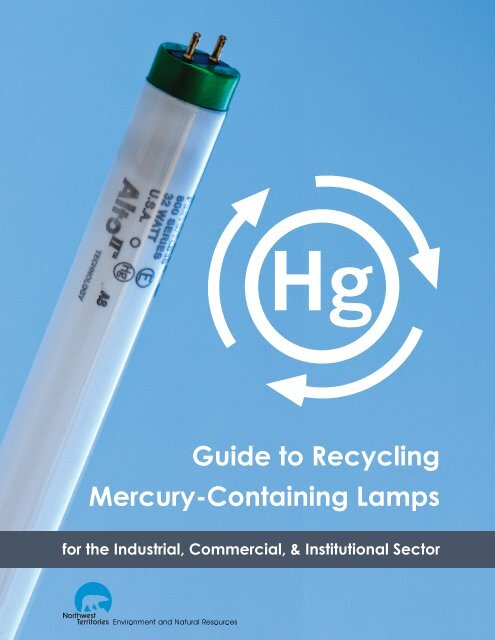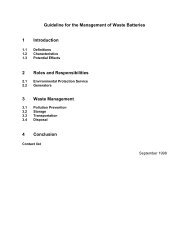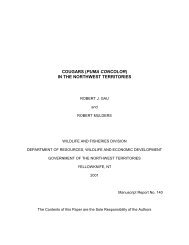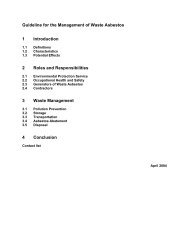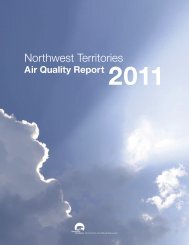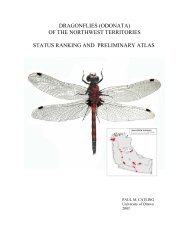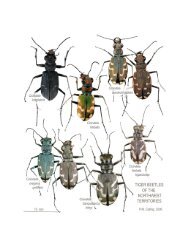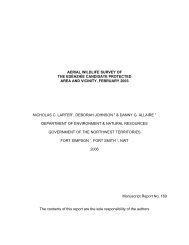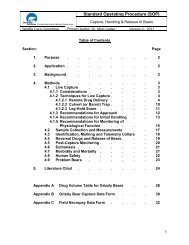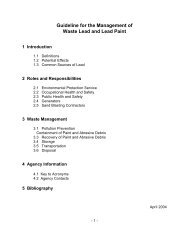What are Mercury-containing Lamps? - Environment and Natural ...
What are Mercury-containing Lamps? - Environment and Natural ...
What are Mercury-containing Lamps? - Environment and Natural ...
Create successful ePaper yourself
Turn your PDF publications into a flip-book with our unique Google optimized e-Paper software.
Guide to Recycling<br />
<strong>Mercury</strong>-Containing <strong>Lamps</strong><br />
for the Industrial, Commercial, & Institutional Sector<br />
1
Contents<br />
Contents<br />
II I<br />
1 Introduction<br />
2 <strong>What</strong> <strong>are</strong> <strong>Mercury</strong>-<strong>containing</strong> <strong>Lamps</strong>?<br />
3 Why <strong>are</strong> <strong>Mercury</strong>-<strong>containing</strong> <strong>Lamps</strong> recycled?<br />
3 <strong>Mercury</strong> (Hg) Bioaccumulates in the <strong>Environment</strong><br />
3 <strong>Mercury</strong> Effects Human Health<br />
4 Government Regulations<br />
III<br />
4 Small Quantity Exemption<br />
5 How <strong>are</strong> <strong>Mercury</strong>-<strong>containing</strong> <strong>Lamps</strong> recycled?<br />
5 Staff Training<br />
6 Storage<br />
7 Packaging & H<strong>and</strong>ling of <strong>Mercury</strong> -<strong>containing</strong> <strong>Lamps</strong><br />
7 Record Keeping<br />
7 Drum-Top Crushing<br />
8 Off-site Disposal<br />
9 Selecting a Contractor<br />
IV<br />
10 <strong>What</strong> <strong>are</strong> the benefits <strong>and</strong> costs of recycling<br />
10 Benefits<br />
<strong>Mercury</strong>-<strong>containing</strong> <strong>Lamps</strong>?<br />
10 Costs<br />
11 Other Links for more information<br />
12 Appendix I : Types of <strong>Mercury</strong>-Containing <strong>Lamps</strong><br />
12 Compact Fluorescent <strong>Lamps</strong><br />
12 Fluorescent U-Tubes<br />
12 Fluomeric <strong>Lamps</strong><br />
13 Linear Fluorescent <strong>Lamps</strong><br />
13 <strong>Mercury</strong> Vapour <strong>Lamps</strong><br />
13 Metal Halide <strong>Lamps</strong><br />
13 Sodium Vapour <strong>Lamps</strong><br />
14 Appendix II : <strong>What</strong> to do when a <strong>Mercury</strong>-<br />
Containing Lamp Breaks<br />
March 2012
Introduction<br />
<strong>Mercury</strong> is a contaminant <strong>and</strong> an essential<br />
component of many lamps commonly used today.<br />
This guidance document was developed by the<br />
Department of <strong>Environment</strong> <strong>and</strong> <strong>Natural</strong> Resources<br />
(ENR) <strong>and</strong> is intended for property managers, building<br />
maintenance staff, electrical contractors or anyone<br />
else who h<strong>and</strong>les mercury-<strong>containing</strong> lamps in the<br />
Industrial, Commercial <strong>and</strong> Institutional (ICI) sector.<br />
Industrial<br />
Construction, fabrication, light <strong>and</strong> heavy<br />
manufacturing, refineries, chemical plants, power<br />
plants, demolition, etc.<br />
Commercial<br />
Stores, restaurants, markets, office buildings,<br />
hotels, motels, print ships, service stations, auto<br />
repair shops, etc.<br />
Institutional<br />
Schools, hospitals, prisons, governmental<br />
departments, boards <strong>and</strong> agencies. I<br />
This Guide answers the<br />
following questions:<br />
I. <strong>What</strong> <strong>are</strong> mercury-<strong>containing</strong> lamps?<br />
II. Why should they be recycled?<br />
III. How <strong>are</strong> they recycled?<br />
IV. <strong>What</strong> <strong>are</strong> the benefits <strong>and</strong> costs of recycling?<br />
1
<strong>What</strong> <strong>are</strong> <strong>Mercury</strong>-<strong>containing</strong> <strong>Lamps</strong>?<br />
A typical fluorescent lamp (of any shape or type)<br />
is composed of a phosphor coated glass tube with<br />
electrodes at the end(s). The lamp contains mercury<br />
<strong>and</strong> a small amount of an inert gas, typically argon,<br />
kept under very low pressure. When an electrical<br />
charge is applied, the electrodes energize the<br />
mercury vapour, causing it to emit ultraviolet (UV)<br />
energy; the reason for the low energy usage. The<br />
phosphor coating absorbs the UV energy, causing<br />
the phosphor to fluoresce <strong>and</strong> emit visible light.<br />
Inside each lamp the mercury remains in a vapourstate<br />
for proper lamp operation. III<br />
I.<br />
Quantities of <strong>Mercury</strong> in Energy<br />
Efficient <strong>Lamps</strong> <strong>and</strong> <strong>Lamps</strong> with<br />
Reduced <strong>Mercury</strong> II<br />
Type of Lamp<br />
Compact Fluorescent <strong>Lamps</strong><br />
Fluorescent U-Tubes<br />
Fluomeric Lamp<br />
Linear Fluorescent <strong>Lamps</strong> (LFL)*<br />
*<strong>Mercury</strong> Reduced (LFL)<br />
<strong>Mercury</strong> Vapour <strong>Lamps</strong><br />
Metal Halide <strong>Lamps</strong><br />
Sodium Vapour <strong>Lamps</strong><br />
Inside a<br />
Fluorescent<br />
Lamp<br />
Avg. Amount<br />
1-25 mg<br />
3-12 mg<br />
Approx. 2 mg<br />
10-50 mg<br />
3-12 mg<br />
25-225 mg<br />
25-225 mg<br />
20-145 mg<br />
<strong>Mercury</strong>-<strong>containing</strong> lamps can<br />
be recognized by the universally<br />
recognized chemical symbol for<br />
mercury, ‘Hg’ on the lamp.<br />
Contact<br />
Pins<br />
Glass<br />
Tube<br />
<strong>Mercury</strong>-<strong>containing</strong> lamps <strong>are</strong> used for their energy<br />
efficiency comp<strong>are</strong>d to other types of lighting. They<br />
<strong>are</strong> three to four times more efficient than nonmercury-<strong>containing</strong><br />
lamps <strong>and</strong> reduce the need for<br />
fossil fuels in generating electricity. This results in a<br />
reduction in greenhouse gas emissions <strong>and</strong> overall<br />
mercury pollution from fossil fuel burning.<br />
The majority of mercury-<strong>containing</strong> lamps used<br />
in the ICI sector in the Northwest Territories (NWT)<br />
<strong>are</strong> disposed of in l<strong>and</strong>fills without any recycling<br />
or mercury collection. Recent information from<br />
<strong>Environment</strong> Canada states that, about 10 percent<br />
of end-of-life mercury-<strong>containing</strong> lamps <strong>are</strong> currently<br />
recycled Canada wide. IV The use of linear fluorescent<br />
lamps (also known as linear fluorescent tubes) is the<br />
most commonly used mercury-<strong>containing</strong> lamp<br />
throughout the ICI sector in the NWT.<br />
This guide does not focus on residential sources of<br />
mercury-<strong>containing</strong> lamps. Residential generation<br />
of mercury-<strong>containing</strong> lamps is estimated to be less<br />
than 15% of the total. V<br />
Internal<br />
Phosphor<br />
Coating<br />
<strong>Mercury</strong><br />
Inert Gas<br />
Electrode<br />
©2001 HowStuffWorks<br />
The different types of mercury-<strong>containing</strong> lamps <strong>are</strong><br />
identified further in Appendix I.<br />
2
Why recycle <strong>Mercury</strong>-<strong>containing</strong> <strong>Lamps</strong>?<br />
II.<br />
The Canadian Council of Ministers of the<br />
<strong>Environment</strong> determined that mercury levels in fish<br />
<strong>and</strong> wildlife across Canada warrant efforts to reduce<br />
atmospheric <strong>and</strong> waterborne emissions derived from<br />
both deliberate use of mercury <strong>and</strong> from incidental<br />
releases of mercury.<br />
Restrictions on the human consumption of fish in<br />
order to safeguard the health of both high fish<br />
consumers (sustenance <strong>and</strong> commercial fishers)<br />
<strong>and</strong> sensitive populations (infants, children <strong>and</strong><br />
women of childbearing age) <strong>are</strong> widespread.<br />
Some of these restrictions <strong>are</strong> derived from lakes<br />
naturally high in mercury, others in lakes <strong>and</strong> rivers<br />
contaminated by historical point source discharges<br />
<strong>and</strong> still others in waters remote from identifiable<br />
sources. Traditional lifestyles may be profoundly<br />
influenced by mercury contamination. VI<br />
<strong>Mercury</strong> Effects Human Health<br />
Today, the main effects of mercury exposure to<br />
humans <strong>are</strong> understood to be neurological, renal<br />
(kidney), cardiovascular <strong>and</strong> immunological impacts.<br />
Chronic exposure to mercury can cause damage to<br />
the brain, spinal cord, kidneys, liver <strong>and</strong> developing<br />
fetus. Exposure to mercury while in the womb can<br />
lead to neurodevelopmental problems in children.<br />
<strong>Mercury</strong> can impair the ability to feel, see, move<br />
<strong>and</strong> taste, <strong>and</strong> can cause numbness <strong>and</strong> tunnel<br />
vision. Long-term exposure can lead to progressively<br />
worse symptoms <strong>and</strong> ultimately personality changes,<br />
stupor, <strong>and</strong> in extreme cases, coma or death. Recent<br />
findings have described adverse cardiovascular <strong>and</strong><br />
immune system effects at very low levels. VII<br />
The Bioaccumulation of Methylmercury<br />
<strong>Mercury</strong> (Hg) Bioaccumulates<br />
in the <strong>Environment</strong> VIII<br />
<strong>Mercury</strong> exists as a gas <strong>and</strong> in a range of organic<br />
(carbon <strong>containing</strong>) <strong>and</strong> inorganic (not <strong>containing</strong><br />
carbon) forms that vary in toxicity <strong>and</strong> persistence<br />
in living organisms. When atmospheric mercury falls<br />
to earth, it may be altered by bacterial or chemical<br />
action into an organic form known as methylmercury.<br />
Bioaccumulation<br />
in Organisms <strong>and</strong><br />
Biomagnification<br />
in the ecosystem<br />
Methylmercury<br />
Methylmercury is much more toxic than the original<br />
metal molecules that drifted in the air, <strong>and</strong> has<br />
the ability to migrate through cell membranes <strong>and</strong><br />
“bioaccumulate” in living tissue. Bioaccumulation<br />
is the process by which a substance builds up in a<br />
living organism from the surrounding air or water, or<br />
through the consumption of contaminated food. In<br />
the following figure, the concept of accumulated<br />
methylmercury is illustrated by the red dots, however<br />
the dots <strong>are</strong> not to scale.<br />
3
Government Regulations<br />
The Guideline for Industrial Waste Discharges outlines<br />
the leachate criteria for solid wastes suitable for<br />
l<strong>and</strong>fill. IX Testing done in the NWT has confirmed that<br />
crushed mercury-<strong>containing</strong> lamps may not pass<br />
the leachate test <strong>and</strong> therefore, <strong>are</strong> managed as<br />
a hazardous waste. The mercury is embodied in<br />
the vapour <strong>and</strong> the phosphor powder of mercury<strong>containing</strong><br />
lamps <strong>and</strong> the mass of the entire lamp is<br />
considered mercury waste.<br />
Unless laboratory results confirm the mercury<strong>containing</strong><br />
lamps meet Industrial Discharge criteria<br />
the mercury-<strong>containing</strong> lamps need to be managed<br />
as a hazardous waste according to the Guideline<br />
for the General Management of Hazardous Waste<br />
in the NWT. X All mercury-<strong>containing</strong> lamps, whether<br />
hazardous or not, will release mercury into the<br />
environment when broken outside of a controlled<br />
recycling process. ENR encourages the recycling of<br />
all mercury-<strong>containing</strong> lamps.<br />
Small Quantity Exemption<br />
The Guideline for the General Management of<br />
Hazardous Waste in the NWT defines ‘small quantity’ to<br />
which the definition of hazardous waste does not apply.<br />
Hazardous waste that is generated in an<br />
amount that is less than 5 kilograms per<br />
month if a solid or 5 litres per month if a liquid;<br />
<strong>and</strong> where the total quantity accumulated<br />
at any one time does not exceed 5 kilograms<br />
or 5 litres. This does not apply to wastes that<br />
<strong>are</strong> mercury or in classes 2.3, 5.1 or 6.1 of<br />
TDGR. These wastes must be generated in an<br />
amount less than 1 kilogram per month if a<br />
solid or 1 litre per month if a liquid; <strong>and</strong> where<br />
the total quantity accumulated at any one<br />
time does not exceed 1 kilogram or 1 litre.<br />
Approximately 75% of mercury-<strong>containing</strong> lamps in<br />
Canada <strong>are</strong> four-foot (T-8 or T-12) fluorescent lamps. XI<br />
The mass of the entire lamp is considered mercury<br />
waste <strong>and</strong> it takes approximately four of these fourfoot<br />
fluorescent lamps to amount to 1 kg of mercury<strong>containing</strong><br />
lamps. XII<br />
4 lamps / month = 1 kg mercury waste / month<br />
The average life of a T8 fluorescent lamp is<br />
approximately three years or 1000 days. XIII The rate at<br />
which a functioning lamp becomes a waste lamp is<br />
approximately 1/1000 days. The rate of waste lamps<br />
generated per month is calculated as follows:<br />
1 lamp / 1000 days x 30 days/month<br />
= 0.03 lamps / month = 3% of total lamps.<br />
The amount of waste lamps generated per<br />
month represents approximately 3% of the total<br />
number of lamps.<br />
The total number of lamps that generate<br />
1 kg of mercury waste per month, or 4 lamps is<br />
calculated as follows:<br />
Total number of lamps = 4 lamps / 3%<br />
= approximately 130 lamps<br />
It is understood the calculations above assume<br />
mercury-<strong>containing</strong> lamps come out of service at a<br />
uniform rate. In reality lamps come out of service in<br />
non uniform rates, <strong>and</strong> at any given time a building<br />
will generate more or less than a three percent of<br />
the total number mercury-<strong>containing</strong> lamps. The best<br />
practice is to recycle all waste mercury-<strong>containing</strong><br />
lamps regardless of the total number of lamps.<br />
Building with Less than 130<br />
Fluorescent <strong>Lamps</strong> (bulbs)<br />
The owners of buildings with less than 130 Fluorescent<br />
<strong>Lamps</strong> <strong>are</strong> strongly encouraged to seek out<br />
recycling options for fluorescent lamps. Based on the<br />
above approximations, a building <strong>containing</strong> less<br />
than 130 fluorescent bulbs generates less than 1kg of<br />
mercury-<strong>containing</strong> lamps per month. A generator<br />
is exempt from the requirements of the Guideline for<br />
the General Management of Hazardous Waste if the<br />
waste generated is less than 1 kg of hazardous waste<br />
per month.<br />
Building with 130 or more<br />
Fluorescent <strong>Lamps</strong> (bulbs)<br />
The owners of a building with more than 130<br />
fluorescent lamps <strong>are</strong> required to divert mercury<strong>containing</strong><br />
lamps from regular solid waste <strong>and</strong><br />
manage all these lamps as a hazardous waste.<br />
4
How <strong>are</strong> <strong>Mercury</strong>-Containing<br />
<strong>Lamps</strong> recycled?<br />
III.<br />
Lamp Recycling is Easy<br />
Fluorescent lamps <strong>are</strong> recycled by separating the<br />
glass, mercury, phosphor powder, <strong>and</strong> aluminum<br />
by crushing <strong>and</strong> then capturing the mercury vapour.<br />
There <strong>are</strong> currently no centralized facilities to recycle<br />
these components in the NWT. Drum top crushers<br />
may be used to crush the glass <strong>and</strong> capture the<br />
mercury vapour in filters. ENR can loan a drum top<br />
bulb crusher, at no cost, depending on availability of<br />
a unit <strong>and</strong> on the condition the employer develops<br />
a detailed safe work plan. Once the crushed lamps<br />
have been consolidated in drums, the materials <strong>are</strong><br />
transported to facilities where further separation<br />
takes place under pressure <strong>and</strong> heat before<br />
recycling them separately. XIV It is also possible to<br />
transport intact lamps directly to recycling facilities.<br />
The <strong>Mercury</strong>-<strong>containing</strong> Lamp Recycling Flow Chart<br />
(upper right) can be used to help determine details<br />
suitable for specific facilities.<br />
Staff Training<br />
Prior to off-site disposal the following measures<br />
need to be taken:<br />
XXplacing spent lamps in a designated storage<br />
<strong>are</strong>a instead of the garbage;<br />
XXavoiding intentional breakage of lamps; <strong>and</strong>,<br />
XXpreparing bulbs for transportation.<br />
Prior to off-site disposal fluorescent lamps may be<br />
crushed on-site for volume reduction. This option<br />
requires the employer to develop a detailed safe<br />
work plan for the use of drum top bulb crushing<br />
equipment. The use of drum top bulb crushers<br />
requires c<strong>are</strong>ful attention to the use of the<br />
equipment to prevent worker exposure to mercury<br />
vapour. There is no cost to utilize the drum top bulb<br />
crusher from ENR. See the section on off-site disposal<br />
for further details.<br />
Designate a <strong>Mercury</strong>-Containing Lamp Storage Area<br />
XXAssess the mercury-<strong>containing</strong> Lamp Storage<br />
Area <strong>and</strong> determine an accumulation limit.<br />
XXLabel the <strong>are</strong>a, (e.g.“Waste mercury-<strong>containing</strong><br />
Lamp Storage Area”)<br />
XXInclude designated containers/boxes to store<br />
the used bulbs as they accumulate.<br />
Take <strong>Mercury</strong>-Containing Lamp Out of Service<br />
XXStore mercury-<strong>containing</strong> Lamp in Designated<br />
Storage Area,<br />
XXLabel boxes with expired mercury-<strong>containing</strong><br />
<strong>Lamps</strong> differently from unused lamps.<br />
XXEnsure mercury-<strong>containing</strong> lamps <strong>are</strong> stored in a<br />
manner that prevents breakage, <strong>and</strong> close boxes.<br />
Conduct Weekly Inspections of Storage Area<br />
XXCheck for improperly stored bulbs or<br />
damaged bulbs<br />
XXContain mercury-<strong>containing</strong> lamps showing<br />
evidence of breakage / damage. Do not try<br />
<strong>and</strong> remove debris from the bottom of a box.<br />
XXLeave broken lamps in box <strong>and</strong> seal the box<br />
<strong>and</strong> store separately from undamaged bulbs<br />
XXRecord the number of lamps in the storage <strong>are</strong>a<br />
<strong>and</strong> comp<strong>are</strong> to accumulation limit<br />
Once Accumulation Limit is anticipated, or has<br />
been reached contact “off-site disposal option”.<br />
5
Storage<br />
The first step a generator of mercury-<strong>containing</strong><br />
lamps must take is to inform all employees about<br />
the proper h<strong>and</strong>ling <strong>and</strong> procedures for damaged<br />
lamps. Health Canada’s guidance on what to<br />
do when a lamp breaks (Appendix II) should be<br />
reviewed by owners <strong>and</strong> any staff h<strong>and</strong>ling mercury<strong>containing</strong><br />
lamps. It can also be viewed online at:<br />
www.hc-sc.gc.ca/hl-vs/iyh-vsv/prod/cfl-afc-eng.php.<br />
The normal h<strong>and</strong>ling of spent fluorescent lamps does<br />
not present any health <strong>and</strong> safety risks.<br />
The second step in recycling lamps is to divert them<br />
from the waste stream <strong>and</strong> designate a suitable<br />
storage <strong>are</strong>a. A dedicated storage <strong>are</strong>a should be<br />
located in an <strong>are</strong>a, which can be locked, away<br />
from human traffic to prevent tampering. The <strong>are</strong>a<br />
should be dry <strong>and</strong> have good ventilation. It should<br />
not be a general workspace. The following factors<br />
should be considered when selecting a storage<br />
<strong>are</strong>a:<br />
X X <strong>What</strong> type of lamps <strong>and</strong> how many <strong>are</strong> going<br />
to be collected between for offsite disposal or<br />
crushing operations?<br />
X X <strong>What</strong> types <strong>and</strong> size of recycling containers will<br />
be needed? Where should they be placed?<br />
X X <strong>What</strong> is the accumulation limit of the<br />
storage <strong>are</strong>a or the number of bulbs that can<br />
be safely stored?<br />
X X How can it be kept convenient for<br />
employee access?<br />
Improper Storage (above) <strong>and</strong> Good Storage (below)<br />
Packaging <strong>and</strong> H<strong>and</strong>ling of<br />
<strong>Mercury</strong>-Containing <strong>Lamps</strong><br />
XXDo not tape lamps together. This makes them<br />
difficult to separate for crushing.<br />
X X Packaging in between lamps is not required<br />
but each box should be filled to capacity to<br />
prevent movement.<br />
X X Ensure the bottoms of boxes <strong>are</strong> secure <strong>and</strong><br />
can support the weight of the contents.<br />
X X Do not over-pack a box or a drum so that any<br />
movement will cause a bulb to break.<br />
X X Do not place heavy objects on top of boxes or<br />
individual fluorescent lamps.<br />
X X Ensure each container is labelled to distinguish<br />
spent lamps from unused lamps.<br />
X X For high intensity discharge lamps or other nonstraight<br />
lamps use any sturdy cardboard box for<br />
storage. Wrap one sheet of newspaper around<br />
the lamp, or slip it back into its original casing.<br />
Be sure to put a label on the box <strong>and</strong> date it.<br />
X X If a lamp breaks in the box or drum, leave it<br />
alone. Do not attempt to remove the broken<br />
lamp, or its parts, from the container. Broken<br />
bulbs can be added to a drum of crushed glass<br />
when available.<br />
6
Record Keeping<br />
It is important to keep a record of when the<br />
accumulation limit has been reached <strong>and</strong> offsite<br />
disposal or bulb crushing is required. The<br />
accumulation limit is different for each facility <strong>and</strong><br />
depends on the size of the facility <strong>and</strong> the size of the<br />
storage space.<br />
Record keeping of accumulation limits can be<br />
accomplished by following these simple measures:<br />
XXKeep a running total of the number of spent<br />
mercury-<strong>containing</strong> lamps placed in a storage<br />
<strong>are</strong>a by updating a list each time a mercury<strong>containing</strong><br />
lamp is added to the <strong>are</strong>a; or,<br />
X X Place the mercury-<strong>containing</strong> lamp in a specific<br />
accumulation <strong>are</strong>a <strong>and</strong> identify the earliest<br />
date any mercury-<strong>containing</strong> lamp in the <strong>are</strong>a<br />
became a waste.<br />
XXRecord keeping is also required for off-site<br />
disposal. A movement document (hazardous<br />
waste manifest) is required to track the disposal of<br />
all hazardous wastes from registered generators,<br />
carriers, to registered receiving facilities.<br />
A movement document is not required if intact bulbs<br />
<strong>are</strong> transported to a contractor for crushing prior to<br />
transportation to a registered receiving facility. In this<br />
case, some form of record keeping (e.g., waybill,<br />
chain of custody, bill of lading) outlining who is in<br />
charge, management, <strong>and</strong> control of the mercury<strong>containing</strong><br />
lamps at any given time is strongly<br />
recommended. A movement document is required<br />
when crushed lamps or intact lamps <strong>are</strong> transported<br />
to registered hazardous waste receiving facilities.<br />
ENR’s <strong>Environment</strong> Division provides movement<br />
documents at no cost.<br />
Drum-Top Crushing<br />
Drum-top crushing is done using a mechanical<br />
device that fits on top of a 205 L (45-gallon)<br />
collection drum. Whole lamps <strong>are</strong> broken in the<br />
system but components <strong>are</strong> not separated. The drum<br />
will contain hazardous mercury, phosphor powder,<br />
glass <strong>and</strong> mixed metals. Crushing lamps into drums<br />
releases mercury into the filter. This filter medium also<br />
becomes hazardous. Drum-top crushing can be<br />
done safely by following manufacturer’s instructions<br />
<strong>and</strong> developing a detailed safe work plan. The<br />
drum-top bulb crushing machines were intended<br />
to be used indoors in well-ventilated <strong>are</strong>as even<br />
though there is some mercury vapour released from<br />
the equipment while it is in operation. It is possible for<br />
workers to become overexposed if precautions <strong>are</strong><br />
not followed.<br />
If the preferred option for recycling fluorescent lamps<br />
is on-site crushing using available staff <strong>and</strong> ENR’s<br />
bulb crusher, a detailed safe work plan will have to<br />
be developed. Please contact ENR’s <strong>Environment</strong><br />
Division for further information.<br />
7
Off-site Disposal<br />
There <strong>are</strong> several disposal options available to<br />
generators of waste mercury-<strong>containing</strong> lamps.<br />
These include:<br />
I. Obtaining the services of a hazardous waste<br />
contractor to remove bulbs from the building.<br />
II. Transporting intact bulbs to a receiving facility<br />
or contractor.<br />
III. Hiring a contractor to crush bulbs on site <strong>and</strong><br />
then dispose of the crushed glass.<br />
IV. Using a drum-top bulb crusher <strong>and</strong> arranging<br />
transport directly.<br />
<strong>Mercury</strong>-<strong>containing</strong> lamps may be transported as<br />
intact bulbs, or as crushed glass in drums. There <strong>are</strong><br />
different labelling <strong>and</strong> paperwork requirements for<br />
each transportation method.<br />
Disposing of Intact <strong>Lamps</strong>:<br />
XXMust be packaged to prevent breakage during<br />
transport;<br />
XXCannot be disposed of at community disposal<br />
facilities;<br />
XXMay be transported to contractors for crushing<br />
before ultimate disposal;<br />
XXDoes not need special labelling or paperwork<br />
requirements;<br />
XXMust confirm the lamps have been transported<br />
to contractors who <strong>are</strong> trained to manage<br />
mercury-<strong>containing</strong> lamps; <strong>and</strong>,<br />
XXMay use a movement document (hazardous<br />
waste manifest) to track the shipment between<br />
generator <strong>and</strong> contractor or receiving facility.<br />
Disposing of Crushed <strong>Lamps</strong>:<br />
XXMust be packaged in sound sealable means of<br />
containment (i.e. drums, pails);<br />
XXMust be labelled <strong>and</strong> shipped according to<br />
the requirements of the province or territory of<br />
destination;<br />
XXMust be accompanied by a movement<br />
document (hazardous waste manifest); <strong>and</strong>,<br />
XXMust be transported to appropriately receiving<br />
facilities of Hazardous Waste.<br />
Option<br />
I<br />
Waste mercury-<strong>containing</strong><br />
lamp storage <strong>are</strong>a.<br />
Contractors<br />
receiving<br />
facility<br />
Intact bulbs<br />
Option<br />
II<br />
Option<br />
III<br />
On-site<br />
Contractors<br />
Hazardous Waste<br />
Receiving Facility<br />
Option<br />
IV<br />
Crushed mercury<br />
<strong>containing</strong> lamps<br />
8
Selecting a Contractor<br />
A range of contractors <strong>and</strong> services may be<br />
available to the generator, depending on the<br />
region. Some of the options mentioned in Section<br />
II may influence the decision to use the services of<br />
a contractor. It is important to select a contractor<br />
who can ensure mercury-<strong>containing</strong> lamps <strong>are</strong><br />
effectively managed to prevent the release of<br />
mercury regardless of where the crushing of lamps<br />
takes place.<br />
There <strong>are</strong> very few options in many communities to<br />
transport the mercury-<strong>containing</strong> lamps to registered<br />
receiving facilities. In these cases, a contractor<br />
acts as an intermediary between a generator <strong>and</strong><br />
ultimate disposal at registered receiving facilities.<br />
The Guideline for the General Management of<br />
Hazardous Waste in the NWT states:<br />
The generator is ultimately responsible for<br />
ensuring hazardous waste will be properly<br />
managed from the time it is generated<br />
to final disposal. Waste must be properly<br />
stored, transported, treated <strong>and</strong> disposed.<br />
Contractors can manage waste on behalf<br />
of the generator however, the generator is<br />
responsible for ensuring, in advance, that the<br />
waste management method is acceptable.<br />
Important selection criteria to consider<br />
when choosing a contractor include:<br />
1. Is the company a hazardous waste<br />
contractor?<br />
2. Is the company a registered as a generator<br />
carrier or receiver with the applicable<br />
province or territory?<br />
3. Is the contractor’s primary business suitable for<br />
the collection of mercury-<strong>containing</strong> lamps?<br />
4. Are they aw<strong>are</strong> of applicable health <strong>and</strong><br />
safety as well as environmental regulations?<br />
5. Does the contractor have a health<br />
<strong>and</strong> safety plan?<br />
6. <strong>What</strong> type of services does the contractor<br />
provide (i.e. pick-up, disposal, crushing)?<br />
7. <strong>What</strong> kind of assurances does the contractor<br />
provide that mercury-<strong>containing</strong> lamps will be<br />
disposed of at a registered receiving facility?<br />
Suitable contractors may be waste management<br />
companies, electricians, or other technical trade<br />
people in the community. Please contact ENR’s<br />
<strong>Environment</strong> Division if a suitable contractor cannot<br />
be found. The Recycling Council of Alberta list of<br />
companies that recycle mercury-<strong>containing</strong> lamps<br />
can be found on-line at: www.recycle.ab.ca/<br />
fluorescent-lamps-processing.<br />
A list of hazardous waste receiving facilities in the<br />
Alberta <strong>and</strong> British Columbia can be found online at:<br />
XX<br />
http://environment.gov.ab.ca/info/library/8121.pdf<br />
XXwww.hazwastebc.com/categories/mercury/<br />
9
<strong>What</strong> <strong>are</strong> the benefits <strong>and</strong> costs of<br />
recycling <strong>Mercury</strong>-<strong>containing</strong> <strong>Lamps</strong>?<br />
IV.<br />
Benefits<br />
XXReduced amount of mercury released into<br />
the environment.<br />
XXReduced risk of occupational exposure<br />
to mercury from crushed bulbs in disposal<br />
containers.<br />
XXA property owner’s positive image associated<br />
with disposing of mercury-<strong>containing</strong><br />
lamps responsibly.<br />
XX<br />
Compliance with NWT environmental st<strong>and</strong>ards.<br />
Costs<br />
Estimated Costs of disposing of<br />
Fluorescent <strong>Lamps</strong><br />
Disposal of a 205 L<br />
drum of crushed glass<br />
Transportation<br />
(varies depending on community)<br />
Cost of a drum<br />
Total<br />
$250<br />
$200 Est.<br />
$100 Est.<br />
$550*<br />
Each 205 L drum can contain approx. 800 4’ bulbs**<br />
Cost of one drum = $550 / 800 bulbs<br />
= approx. $0.70/bulb<br />
*This estimate does not account for staff time<br />
if crushing of the lamps is done on site or by a<br />
contractor.<br />
**A drum will hold a lesser quantity of lamps if<br />
eight-foot lamps, or if compact fluorescent lamps<br />
<strong>are</strong> crushed.<br />
High Intensity discharge (HID) lamps <strong>are</strong> more<br />
expensive to dispose because size reduction is not<br />
a viable option in the NWT. Based on estimates in<br />
the U.S., HID lamps <strong>are</strong> approximately five times as<br />
expensive to recycle as linear fluorescent tubes. XV<br />
10
Links to more information<br />
ENR Headquarters <strong>and</strong> Regional Offices<br />
<strong>Environment</strong><br />
Division<br />
600, 5102-50th Ave.<br />
Yellowknife NT X1A 3S8<br />
Tel: (867) 873-7654<br />
Fax: (867) 873-0221<br />
South Slave Region<br />
Box 900<br />
Fort Smith NT X0E 0P0<br />
Tel: (867) 872-6400<br />
Fax: (867) 872-4628<br />
North Slave Region<br />
Box 2668<br />
Yellowknife NT X1A 2P9<br />
Tel: (867) 873-7184<br />
Fax: (867) 873-6230<br />
Dehcho Region<br />
Box 240<br />
Fort Simpson X0E 0N0<br />
Tel: (867) 695-7450<br />
Fax: (867) 695-2381<br />
Sahtu Region<br />
PO Box 149<br />
Norman Wells NT X0E 0V0<br />
Tel: (867) 587-3500<br />
Fax: (867) 587-3516<br />
Inuvik Region<br />
P.O. Box 2749<br />
Shell Lake X0E 0T0<br />
Tel: (867) 678-6650<br />
Fax: (867) 678-6659<br />
WSCC Workers’ Safety &<br />
Compensation Commission<br />
Yellowknife<br />
5022 49th Street<br />
5th Floor, Centre Squ<strong>are</strong><br />
Tower<br />
Box 8888<br />
Yellowknife, NT X1A 2R3<br />
Tel: (867) 920-3888<br />
Fax: (867) 873-4596<br />
Toll Free<br />
Tel: 1-800-661-0792<br />
Fax: 1-866-277-3677<br />
Inuvik<br />
3rd Floor<br />
Mack Travel Building<br />
151 Mackenzie Road<br />
Box 1188<br />
Inuvik, NT X0E 0T0<br />
Tel: (867) 678-2301<br />
Fax: (867) 678-2302<br />
Guideline for the General Management of Hazardous<br />
Waste in the NWT:<br />
www.enr.gov.nt.ca/_live/documents/content/<br />
General_management.pdf<br />
GNWT 1998, Guideline for Industrial Waste Discharges<br />
in the NWT:<br />
www.enr.gov.nt.ca/_live/documents/content/<br />
industrial_waste_guidelines.pdf<br />
Association of Lighting <strong>and</strong> <strong>Mercury</strong> Recyclers:<br />
www.almr.org/<br />
Recycling Council of Alberta Directory Listings:<br />
www.recycle.ab.ca/ebguide<br />
CCME Canada Wide St<strong>and</strong>ard for <strong>Mercury</strong>-<br />
Containing <strong>Lamps</strong>:<br />
www.ccme.ca/assets/pdf/merc_lamp_st<strong>and</strong>ard_e.pdf<br />
<strong>Environment</strong> Canada, <strong>Mercury</strong> <strong>and</strong> the <strong>Environment</strong>:<br />
www.ec.gc.ca/mercure-mercury/default.<br />
asp?lang=En&n=DB6D2996-1<br />
<strong>Environment</strong> Canada, Technical Recommendations<br />
Document on the Management of End-of-life<br />
<strong>Mercury</strong>-Containing <strong>Lamps</strong> in Canada:<br />
www.ec.gc.ca/mercure-mercury/default.<br />
asp?lang=En&n=5CA51DB2<br />
<strong>Natural</strong> Resources Canada’s Fluorescent <strong>Lamps</strong> -<br />
Questions <strong>and</strong> Answers:<br />
http://oee.nrcan.gc.ca/residential/business/<br />
manufacturers/11423<br />
Lamprecycle.org:<br />
www.lamprecycle.org/<br />
11
Appendix I : Types of <strong>Mercury</strong>-Containing <strong>Lamps</strong><br />
Compact Fluorescent <strong>Lamps</strong><br />
Use: Compact fluorescent lamps <strong>are</strong> frequently used<br />
in place of traditional inc<strong>and</strong>escent<br />
lights in the hospitality industry, offices, <strong>and</strong> home<br />
lighting systems.<br />
Description: Compact fluorescent lamps have<br />
all the same characteristics as linear fluorescent<br />
tubes, except they have been designed to<br />
replace inc<strong>and</strong>escent bulbs, which <strong>are</strong> common<br />
in residential, commercial, industrial, <strong>and</strong> accent<br />
lighting applications.<br />
Identification: Compact fluorescent lamps <strong>are</strong><br />
similar in size to the inc<strong>and</strong>escent bulb; however,<br />
the bulb has been replaced with a coiled, compact<br />
fluorescent tube.<br />
Fluorescent U-Tubes<br />
Use: Fluorescent U-Tubes <strong>are</strong> used in appliances,<br />
ceiling fixtures, <strong>and</strong> display cases. They <strong>are</strong> useful when<br />
fluorescent light is desired, but the available space is<br />
too small for traditional linear fluorescent lamps.<br />
Fluomeric <strong>Lamps</strong><br />
Use: Fluomeric lamps <strong>are</strong> used as replacement<br />
lamps for inc<strong>and</strong>escent systems for a variety of<br />
applications. High-wattage fluomeric lamps have<br />
long-burning life (up to 20,000 hours) <strong>and</strong> <strong>are</strong> ideal<br />
for high-bay lighting applications such as industrial<br />
lighting, repair shops, street lighting, building<br />
facades, security lighting, billboards, <strong>and</strong> sports<br />
<strong>are</strong>nas. Smaller lower wattage models <strong>are</strong> suitable<br />
for schools, stores, <strong>and</strong> display lighting.<br />
Description: These lamps <strong>are</strong> self-ballast <strong>and</strong><br />
produce brighter light than inc<strong>and</strong>escent lamps.<br />
No ballast, wiring, or special fixtures <strong>are</strong> required<br />
to retrofit existing inc<strong>and</strong>escent fixtures (Duro-test<br />
lighting, 2003).<br />
Identification: Fluomeric lamps <strong>are</strong> not very<br />
distinguishable from regular inc<strong>and</strong>escent<br />
lamps. They can be clear, white (frosted colour),<br />
<strong>and</strong> reflector flood (aluminum reflector with a<br />
frosted face). Product labeling <strong>and</strong> packaging<br />
should be examined to determine whether the<br />
lamp is fluomeric.<br />
Description: Fluorescent U-Tubes have all the same<br />
characteristics as linear fluorescent tubes, except<br />
they take up half the space of a comparable<br />
linear fluorescent.<br />
Identification: Fluorescent U-Tubes can be identified<br />
by the distinct U-shaped fluorescent tube.<br />
12
Linear Fluorescent <strong>Lamps</strong><br />
Use: Fluorescent lamps <strong>are</strong> commonly used to<br />
illuminate offices, stores, w<strong>are</strong>houses, street corners,<br />
<strong>and</strong> homes.<br />
Description: Fluorescent lamps <strong>are</strong> sealed glass tubes<br />
that contain small amounts of mercury (an essential<br />
component), inert gas, <strong>and</strong> phosphor powder<br />
coated along the inside of the tubes. Fluorescent<br />
lamps <strong>are</strong> highly efficient, using electric discharge<br />
through low-pressure mercury vapour to produce<br />
ultraviolet (UV) energy.<br />
Identification: Fluorescent lamps generally range<br />
in diameter from 2.54 to 3.81 centimetres (1 to 1.5<br />
inches); <strong>and</strong> in length from 0.61 to 2.44 meters (2 feet<br />
to 8 feet). <strong>Mercury</strong>-reduced fluorescent lamps can<br />
have a green b<strong>and</strong> or writing at the ends.<br />
<strong>Mercury</strong> Vapour <strong>Lamps</strong><br />
Use: <strong>Mercury</strong> vapour lamps <strong>are</strong> frequently found<br />
in several high intensity discharge (HID) lamp<br />
applications. They <strong>are</strong> used as farmyard lights, for<br />
street lighting <strong>and</strong> general floodlighting, <strong>and</strong> in<br />
parking lots.<br />
Description: The lamp consists of a glass envelope<br />
with a pinched quartz glass tube <strong>and</strong> various metal<br />
electrodes within. An electronic current is passed<br />
through to form an arc to display light.<br />
Identification: Light emission is identifiable by a bluish<br />
glow. The quality of colour rendition is not as good as<br />
metal halide or high-pressure sodium vapour lamps.<br />
Metal Halide <strong>Lamps</strong><br />
Use: Metal halide lamps <strong>are</strong> used to light sport<br />
stadium fields <strong>and</strong> other <strong>are</strong>as where a very bright<br />
light is required.<br />
Description: Metal halide lamps <strong>are</strong> the brightest<br />
light available <strong>and</strong> <strong>are</strong> frequently found in several<br />
HID applications. They offer better lighting than<br />
mercury or sodium vapour lamps. Metal halide lamps<br />
can take up to 5 minutes to light up after being<br />
switched on; or 20 minutes if turned off <strong>and</strong> on again<br />
(ignition <strong>and</strong> restrike). This light emits a bright white<br />
light close in quality to inc<strong>and</strong>escent lamps. Lights<br />
must be matched up with ballasts. These lamps<br />
<strong>are</strong> not interchangeable with other high intensity<br />
discharge (HID) (Florida Power <strong>and</strong> Light, 2003).<br />
Identification: Consists of glass envelope with<br />
a pinched quartz glass tube <strong>and</strong> various metal<br />
electrodes within. An electronic current is passed<br />
through to form an arc <strong>and</strong> then a light display.<br />
Sodium Vapour <strong>Lamps</strong><br />
Use: Sodium Vapour lamps <strong>are</strong> economical<br />
high intensity discharge (HID) lamps used for street<br />
lighting <strong>and</strong> general floodlighting <strong>and</strong><br />
in parking lots.<br />
Description: Sodium vapour lamps consist of a<br />
glass envelope with a pinched quartz glass tube<br />
<strong>and</strong> various metal electrodes within. An electronic<br />
current is passed through to form an arc <strong>and</strong> then a<br />
light display. There <strong>are</strong> two general models of sodium<br />
vapour lamps: high-pressure sodium (70-1000 watts)<br />
<strong>and</strong> low-pressure sodium (35-180 watts) (Lamptech,<br />
2003).<br />
Identification: Light emission is identifiable by a<br />
yellowish glow.<br />
13
Appendix II : <strong>What</strong> to do when a<br />
mercury-<strong>containing</strong> lamp breaks.<br />
If you break a <strong>Mercury</strong><br />
Containing Lamp follow these<br />
directions for clean-up:<br />
Leave the room<br />
XXRemove people <strong>and</strong> pets from the room <strong>and</strong><br />
keep them out of the room during the clean-up<br />
process.<br />
XXAvoid stepping on any broken glass.<br />
Ventilation<br />
XXVentilate the room for at least 15 minutes prior<br />
to starting clean-up by opening windows <strong>and</strong><br />
doors to the outdoors. This will ensure that<br />
mercury vapour levels <strong>are</strong> reduced before you<br />
start cleaning.<br />
Clean-up Directions for Hard<br />
<strong>and</strong> Carpeted Surfaces<br />
XXDo not use a vacuum to clean up the initial<br />
breakage, as it will spread the mercury vapour<br />
<strong>and</strong> dust throughout the <strong>are</strong>a <strong>and</strong> may<br />
contaminate the vacuum.<br />
XXWear disposable gloves, if available, to avoid<br />
direct contact with mercury <strong>and</strong> to prevent cuts.<br />
XXScoop or sweep up the broken pieces<br />
<strong>and</strong> debris with two pieces of stiff paper or<br />
cardboard. Do not use a broom.<br />
XXUse sticky tape, such as duct tape or masking<br />
tape, to pick up any remaining fine glass or<br />
powder.<br />
XXWipe the <strong>are</strong>a with a damp paper towel, cloth<br />
or disposable wet wipe to remove any residual<br />
particles.<br />
XXPlace the broken glass <strong>and</strong> clean-up materials in<br />
a glass container with a tight fitting lid to further<br />
minimize the release of mercury vapour.<br />
Carpeting - Steps to Take After<br />
the Initial Clean-up<br />
XXIf the rug is removable, take it outside, shake <strong>and</strong><br />
air it out for as long as is practical.<br />
XXThe first time you vacuum on installed carpet<br />
after the clean-up, shut the door to the room<br />
or close off the <strong>are</strong>a as much as possible <strong>and</strong><br />
ventilate the room in which the lamp was<br />
broken by opening the windows <strong>and</strong> doors<br />
to the outside. When the vacuuming is done,<br />
remove the bag, wipe the vacuum with<br />
a damp paper towel, cloth or disposable<br />
wet wipe, <strong>and</strong> then place the vacuum bag<br />
<strong>and</strong> paper towel in a sealed plastic bag<br />
outside. In the case of a canister vacuum,<br />
wipe the canister out with a wet paper towel<br />
<strong>and</strong> dispose of the towel as outlined above.<br />
Continue to ventilate the room for 15 minutes<br />
once the vacuuming is completed.<br />
Broken <strong>Lamps</strong> inside a box<br />
XXWhen a broken mercury <strong>containing</strong> lamp is<br />
discovered in a box seal the box with tape if<br />
possible while still <strong>containing</strong> the broken glass<br />
inside the box.<br />
XXDo not attempt to remove the broken glass<br />
indoors or in a poorly ventilated <strong>are</strong>a.<br />
XXMove the box outdoors in a secure <strong>are</strong>a, <strong>and</strong><br />
arrange to have the glass disposed of with other<br />
mercury <strong>containing</strong> lamps that <strong>are</strong> intact.<br />
Disposal<br />
XXImmediately place waste material outside of the<br />
building in a protected <strong>are</strong>a.<br />
XXDispose of the waste along with other mercury<br />
<strong>containing</strong> lamps as soon as possible. Check the<br />
off-site disposal plan.<br />
Washing<br />
XXWash your h<strong>and</strong>s after storing <strong>and</strong> disposing<br />
of waste.<br />
14
References<br />
I. Tchobanaglous George, Theisen Hilary,<br />
Vigil Samuel. INTEGRATED SOLID WASTE<br />
MANAGEMENT Engineering Pinciples <strong>and</strong><br />
Management Issues. Irwin McGraw-Hill,<br />
1993, p. 41<br />
II. <strong>Environment</strong> Canada, 2010-06-03. Products<br />
that Contain <strong>Mercury</strong>/ Fluorescent <strong>Lamps</strong>.<br />
Viewed online on January 16, 2012 at<br />
www.ec.gc.ca/mercure-mercury/default.<br />
asp?lang=En&n=2486B388-1<br />
III. How Stuff Works 2005, How Fluorescent<br />
<strong>Lamps</strong> Work website, viewed online on Jan<br />
11,2012 at:<br />
http://home.howstuffworks.com/<br />
fluorescent-lamp2.htm<br />
IV. <strong>Environment</strong> Canada, Technical<br />
Recommendations Document on the<br />
Management of End-of-life <strong>Mercury</strong><strong>containing</strong><br />
<strong>Lamps</strong> in Canada. Viewed online<br />
on January 12, 2012 at:<br />
www.ec.gc.ca/mercure-mercury/default.asp?<br />
lang=En&n=5CA51DB2&offset=1&toc=show<br />
V. SWANA, Promoting <strong>Mercury</strong>-Containing Lamp<br />
Recycling: a Guide for Waste Managers.<br />
Viewed online on January 12, 2012 at:<br />
www.swana.org/extra/lamp/lropmanualfinal.pdf<br />
VI. CANADA WIDE STANDARD for MERCURY-<br />
CONTAINING LAMPS Endorsed by CCME<br />
Council of Ministers, April 30-May 1, 2001,<br />
Winnipeg: Also available online at:<br />
www.ccme.ca/assets/pdf/<br />
merc_lamp_st<strong>and</strong>ard_e.pdf<br />
VII. <strong>Environment</strong> Canada, 2010-06-02. <strong>Mercury</strong><br />
<strong>and</strong> Human Health. Viewed online on January<br />
16, 2012 at:<br />
www.ec.gc.ca/mercure-mercury/default.<br />
asp?lang=En&n=0EB35C98-1<br />
VIII. <strong>Environment</strong> Canada, 2010-06-02. About<br />
<strong>Mercury</strong>. Viewed online on January 16, 2012 at:<br />
www.ec.gc.ca/mercure-mercury/<br />
default.asp?lang=En&n=D64997D2-1<br />
IX. GNWT 1998, Guideline for Industrial Waste<br />
Discharges in the NWT. Also available online at:<br />
www.enr.gov.nt.ca/_live/documents/content/<br />
industrial_waste_guidelines.pdf<br />
X. GNWT 1998. Guideline for the General<br />
Management of Hazardous Waste in the<br />
NWT. Also available online at:<br />
www.enr.gov.nt.ca/_live/documents/content/<br />
General_management.pdf<br />
XI. CANADA WIDE STANDARD for MERCURY-<br />
CONTAINING LAMPS Endorsed by CCME<br />
Council of Ministers, April 30-May 1, 2001,<br />
Winnipeg: Also available online at:<br />
www.ccme.ca/assets/pdf/<br />
merc_lamp_st<strong>and</strong>ard_e.pdf<br />
XII. National Lighting Product Information<br />
Program, Viewed online on January 23, 2012:<br />
www.lrc.rpi.edu/programs/Futures/<br />
LF-LampDisposal/index.asp<br />
XIII. National Lighting Product Information<br />
Program, Viewed online on January 23, 2012:<br />
www.lrc.rpi.edu/programs/nlpip/<br />
lightinganswers/t8/05-t8-lamp-life.asp<br />
XIV. SWANA, Promoting <strong>Mercury</strong>-Containing Lamp<br />
Recycling: a Guide for Waste Managers.<br />
Viewed online on January 23, 2012:<br />
www.swana.org/extra/lamp/lropmanualfinal.pdf<br />
(page 48)<br />
XV. Association of Lighting <strong>and</strong> <strong>Mercury</strong><br />
Recyclers, Education <strong>and</strong> Resources. Viewed<br />
online on January 17, 2012 at:<br />
www.almr.org/resources.html<br />
XVI. <strong>Environment</strong> Canada, 2010-06-03. Products<br />
that Contain <strong>Mercury</strong>/ Fluorescent <strong>Lamps</strong>.<br />
Viewed online on January 16, 2012 at<br />
www.ec.gc.ca/mercure-mercury/<br />
default.asp?lang=En&n=2486B388-1<br />
15


